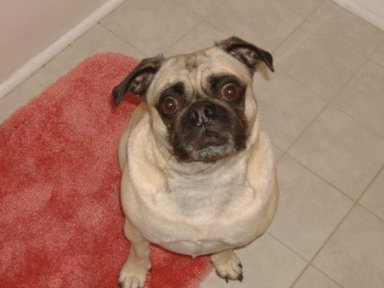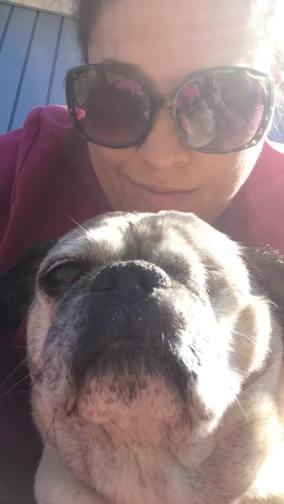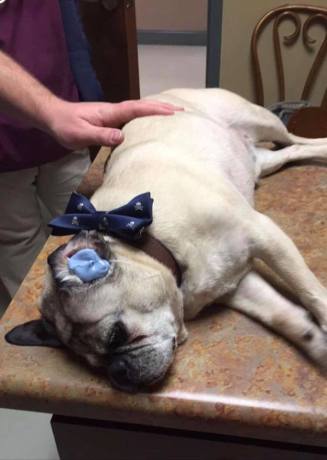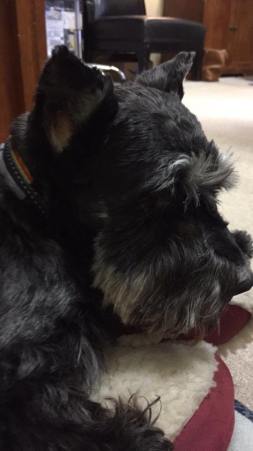About five years ago, my beloved dog and best friend, Brady, started acting a little different. When he was young, he would get so excited when I asked him if he wanted to go for a walk. He would cock his head to the side and open his eyes so wide, I thought they may pop out of his head. I’m definitely guilty of saying the word “walk” with no intention of actually taking him for a walk just so I could chuckle at his goofy expression. He always brightened my day. As he got older, I noticed I had to say the word “walk” a little louder for him to respond. He stopped greeting me at the door because he hadn’t heard me pull up in the driveway. I would have to touch him (or cook something) for him to wake up and it always startled him a little bit. Brady was losing his hearing.

Conveniently, I’d just become licensed as a Hearing Aid Specialist. My dad (a 40-year Audiologist) and I opened our practice, Albemarle Audiology, in Elizabeth City, NC. This has given me the flexibility to research and develop a hearing aid specifically for dogs. Using the resources available to me, for which I am very grateful, I’ve been able to re-purpose human hearing aids to custom fit in almost any dog’s ear, no matter how big or small. So far, I have fit seven dogs with hearing aids, including Brady, who I was in the process of fitting when he crossed the Rainbow Bridge. He was 13 years old and was battling several health issues. I received the dreaded phone call from my Veterinarian advising me to go ahead and prepare myself. Brady was euthanized a week later, peacefully, with his sweet, little head laying on my arm. I’ll never forget holding him for what seemed like hours after he was gone and sobbing into his soft, familiar fur, thanking him for helping me find a purpose in this life.

I’ve had successes and I’ve had even more failures and I can tell you in this blog some of what I’ve learned from both. I’m not an Audiologist, I’m not a Veterinarian, and I’m not a Scientist but I am an avid animal lover and an observant person. I’ve broken up deaf dogs into two groups. There are the dogs that are born with hearing loss (congenitally deaf), which are typically white, piebald, or merle/double merle. I often refer to these dogs as the “white dogs”. Congenital deafness is more prevalent in some breeds than others. Then, there are the dogs that have lost their hearing due to age, noise exposure, certain medications, or some other medical issue. Dogs of any breed or color can lose their hearing but some breeds and colors are more susceptible than others.
Both groups of dogs contain potential candidates for hearing aids but not all dogs with hearing loss will benefit from hearing aids. So far, I have determined candidacy for hearing aids by trial and error. I interview the owner and do simple tests that give me an idea of how much amplification the dog will need. There are several Audiologists around the country that perform BAER tests (brainstem auditory evoked response) on dogs. This is the same test Audiologists perform on young children and it gives more quantitative results. BAER testing is ideal, however it’s also expensive. The equipment can cost tens of thousands of dollars, so it’s not always the most practical approach. I hope to one day have the ability to perform BAER tests on dogs (and other animals!) in my own clinic with a network of providers around the country.
The process of fitting a dog with hearing aids is very similar to fitting a human. Once the dog is evaluated and it is determined that they are a candidate for hearing aids, impressions are taken of the dog’s ears to have the hearing aids manufactured. An impression is a custom mold of the ear canal made by injecting a material (usually silicone) into the dog’s ear to capture the exact size and shape to reproduce the most comfortable and secure hearing aid. Some dogs will tolerate the impression process without sedation and others will need a light sedation to create impressions. The impressions are then sent to a hearing aid manufacturer to be made into custom hearing aids.


The next step is to program the hearing aids to the desired settings. Once they are programmed, it’s time to put them on the dog. This part takes some patience and practice. Most dogs are very adaptable and resilient in new situations (us humans could learn a lot from them!) but they will still need a period of time to accept and get used to the hearing aids. The best way to help your dog get used to his new hearing aids is to have him wear them as much as possible. In my experience, most dogs will paw at them at first but they will eventually give up and go about their life once they realize they can’t get them out of their ears. It is usually around this time that the dog will start to respond to sounds that he doesn’t respond to without the hearing aids. I fit my sister’s senior Schnauzer, Birdie, recently. We could tell right off the bat that she was hearing better when she started wagging her little nub-tail at the sound of my sister’s voice. That one was a tearjerker!





I enjoyed reading your first blog. What an interesting call to action. Your love moves the world.
It wasn’t just the light. That pup has grey hairs. 🙂
LikeLiked by 1 person
Thanks Hazel 😘
LikeLike
I love your Mission! I have Aussies…. and as 3 of them are now 10yrs. old I see them struggling to hear… my mom is deaf in one ear and she recently adopted a double merle aussie who is completely deaf. I have often thought that there MUST be something to help these dogs continue to hear! I think that as they lose their hearing they are less involved in the world around them…. and as a result become less active which starts and adds to the aging cycle. I’m excited to follow your progress and your passion!
LikeLiked by 1 person
I agree, completely! It’s hard to watch your dog or anyone lose their hearing. Thank you!
LikeLike
We have a white pit that is just 13 weeks and she is deaf. She is the love of our life. She is a challenge, but we work hard with her and already have her sitting, lying, begging, stopping, and rolling over on signs. We are in our early 50’s and I am a kidney cancer survivor amongst two heart, one back and numerous other surgeries/health issues (I wear hearing aids too) and we have found she is just what we needed! We need each other! Thank you for helping the hearing impaired dogs.
LikeLiked by 1 person
I love how dogs and people find each other! Congrats on your new addition and thank you!
LikeLike
My Ruby is a double merle catahoula…she turned 1 in January. She was born deaf and blind. Would love more info on hearing aids if possible
LikeLiked by 1 person
Hi Erin! Where are you located?
LikeLike
I adopted a deaf senior dog 2 years ago. He is about 15 now. What I wouldn’t give for him to hear me tell him “I love you”.
LikeLiked by 1 person
That may be possible!
LikeLike
I think my mother in law is a neighbor if yours!! (Bettie Lowe) She was telling me about you… I have a white boxer who was born deaf… anyway saw the link on Deaf Dogs Rock and saw you are in Elizabeth city! Thank you for what you are doing !!! Very interesting reading !!
LikeLiked by 1 person
Awesome, yes she lives behind me! Thank you 🙂
LikeLike
Have a two year rescue pit mix. She is deaf. Would love to see if she is a candidate.
LikeLiked by 1 person
It is a possibility! Where are you located?
LikeLike
how do you get the impression? It would be like taking an impression of a mastoid ear!
LikeLiked by 1 person
Just like a human! Its a lot easier if they are sedated and not moving. I usually use more than one otoblock and just make sure I take my time!
LikeLike
How cool! I am a BCHIS in Charlotte, NC and was just pondering this issue recently. I’m so happy to see your experimenting with it!! Keep up the good work!
LikeLiked by 1 person
Thanks so much! I have had a lot of help 😊
LikeLike
I was so excited to read about your work. I too am a Hearing Instrument Dispenser. A few years back my sweet dog Lucy a springer spaniel experienced hearing loss as she aged. Many times I stuck old donated customs in her ears & could see instant improvement with her hearing. I did battle feed back because of her long ears. She has since passed. But if my new springer ever has hearing loss I will try custom impressions with today’s technology that could probably have no problem with feed back. Thank you & keep up the work
LikeLiked by 1 person
That’s so awesome! What a great testimony. I have had good luck with feedback, so far, but we did just realize that my mom’s Dachsund wouldn’t stop squealing. His floppy ears were making them feedback! We were able to program out most of it out, though. If you ever need help fitting dogs in the future, let me know. 😊
LikeLike
Utterly fantastic! Nice to see our furry kids being treated with such love! I’m going to share this on my FB page that deals with hearing loss and hearing aids.
LikeLiked by 1 person
Thanks, Jeff!
LikeLike
So AWESOME!!! I’m an Audiologist and dog-lover and I think it’s such an awesome thing you are doing!! If you ever need any help give me a shout!! Keep up the good work!!
LikeLiked by 1 person
Thank you so much! Where are you located?
LikeLike
Wow, I just listened and have tears in my eyes! Thank you for taking the time to read my post and share it with your listeners. Also, I just wanted to mention that Westone made custom hearing protection for one of the dogs I’ve worked with. Thanks, again!
LikeLike
Is there anyone around Galena, Il who can fit these? We have a 14 yr old peekshzu who is losing her hearing. What is the cost of these? I think this is great. Our dog is still spry and a “tough” ole dog. She still enjoys gardening, and such but there are days she can barely hear and other days she does better.
LikeLiked by 1 person
Nancy, what is your email address?
LikeLike